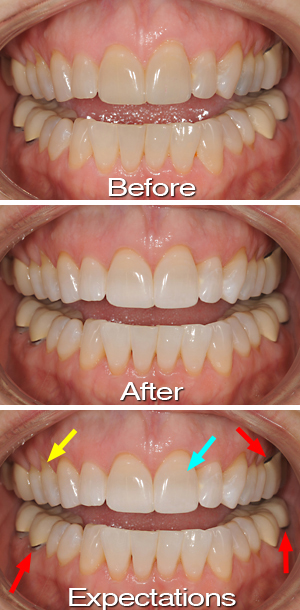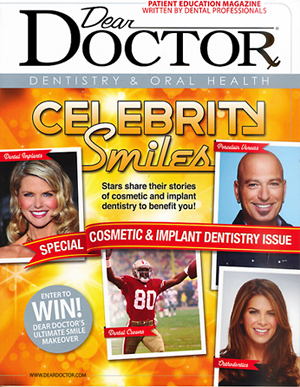“I understand how bleach works. I have even picked the method I think I would prefer. How do I know if it is going to work for me? ”
In a previous post, “Whiter Teeth! (Part 2)”, we explored three methods for applying bleach to whiten teeth. In our last post, “Whiter Teeth! (Part 4)”, we investigated objective and reliable scientific research and concluded that at-home tray bleaching works best.
Understandably, many clients wonder if bleaching results might vary from one person to  the next. They often ask us how well it will work specifically for them. In this post we will review the factors that will determine if you are a good candidate for tooth whitening.
the next. They often ask us how well it will work specifically for them. In this post we will review the factors that will determine if you are a good candidate for tooth whitening.
The images to the right are un-retouched “Before and After” photographs taken of the same patient (using the same camera, flash, exposure settings, and distance) for a fair and unbiased comparison. Did the tooth whitening work? Absolutely. Was the patient happy with the results? Ecstatic! (“My teeth have never been this white,” she claims. “Ever!”) Is everything “perfect” now? Well… The “Expectations” image is identical to the “After” image. I added arrows to point out areas where pre-existing factors created minor (but predictable) limitations in the outcome.
Let’s learn how to recognize those factors.
Initial tooth color
While all teeth are generally ivory in color, everyone is born with an innate tint that ranges from yellowish-brown to greenish-grey. It turns out that the yellowish-brown color is more responsive to tooth bleaching than the green-grey color. Teeth that appear to have a gray stripe through the middle of the tooth can be particularly stubborn when it comes to whiten. (The “Before” photograph of our sample case shows an example of teeth with an overall grayish color.)
Tooth color and age are also directly linked. With wear and stain accumulation, teeth often start to take on a darker cast. With age, the yellow colors can evolve into a darker brownish hue, and those are harder to eliminate.
Several years ago, tetracycline was frequently prescribed to help children battle ear infections. Later it was learned that tetracycline usage during tooth formation could produce horizontal brownish- grayish stripes of discoloration which are very difficult to remove. Excessive consumption of fluoride can cause a splotchy enamel appearance called fluorosis. Although medical doctors now avoid prescribing these medicines during tooth development, millions of people have already developed darkened teeth caused by prescribed medications. (While the teeth in our sample case became significantly whiter, the “Expectations” photo reveals a mild lingering horizontal grayish “stripe”–at the blue arrow—the result of internal tetracycline “staining” acquired from childhood antibiotic treatment decades earlier.)
Of course, the starting color of your teeth matters. You probably wouldn’t be surprised to learn that darker teeth may require extra effort to whiten. Just because the bleaching results are less effective with darker colors does NOT mean that they are ineffective. Repeated procedures over an extended period of time are sometimes required.
Roots and Restorations
Although tooth enamel responds well to tooth whitening solutions, root surfaces don’t. (The yellow arrow points out just one of several areas where this patient had experienced previous gum recession which had exposed her root surfaces. Understandably, those areas did not change color during the bleaching treatment.)
Tooth-colored restorations utilize acrylic or porcelain materials that are also unaffected bleaching solutions. If you have fillings or crowns that currently match your tooth color, they won’t after tooth whitening. (Notice how the red arrows identify several porcelain crowns that didn’t change color at all.) At Snow Dental Care, we avoid using porcelain crowns with unsightly metal edges. If you happen to have a crown with an exposed metal band from treatment in a previous office, however, you probably won’t be surprised to hear that the bleaching treatment cannot help to improve that situation either.
Tooth Translucency
Translucency is an optical property that describes how scattered light can pass through a material. Unlike the transparency of clear water or a pane of glass (that allows all light to pass directly through unimpeded), translucency imparts a white hazy appearance to a material that deflects and reflects a portion of the light that passes through it. When it comes to teeth, this genetically-determined trait becomes more pronounced over time. As tooth wear and optical changes develop with age, translucency increases. Thinning translucent teeth are less-responsive to bleaching.
Consumption
The cliché “you are what you eat” certainly applies to the color of your teeth. If you enjoy  coffee, tea, red wine, or other highly-pigmented foods and beverages, you can expect the dark, colored molecules to become trapped in the microscopic spaces between the crystalline columns that make up your enamel. The same is true for smoking. The use of tobacco can leave dark deposits which slowly penetrate the tooth structure to cause internal intrinsic discoloration.
coffee, tea, red wine, or other highly-pigmented foods and beverages, you can expect the dark, colored molecules to become trapped in the microscopic spaces between the crystalline columns that make up your enamel. The same is true for smoking. The use of tobacco can leave dark deposits which slowly penetrate the tooth structure to cause internal intrinsic discoloration.
Common Sense Conclusions
While all bleaching methods “work” to one degree of another, at-home tray bleaching works best to achieve the brightest and longest-lasting results in the least amount of time for the least total financial investment. This method also has the lowest potential for creating unwanted tooth sensitivity side effects.
Although all tooth enamel predictably becomes lighter and whiter in color after tooth bleach application, patients with exposed roots or existing dental restorations should expect those areas NOT to change color during the tooth whitening process. Restoration replacement is sometime required to achieve a uniformly whiter result.
Similarly, patients with grayish teeth will find them to be less responsive to the tooth whitening procedures that patients with yellow-tinged teeth. In these circumstances, additional repeated procedures over an extended period of time are sometimes required to achieve the desired effect.
While tooth bleaching affects the color of natural tooth structure, it does not alter the appearance of the shape, proportion, or alignment of teeth. For patients who wish to achieve lighter results or mask problems that cannot be addressed with bleaching treatment alone, they may wish to consider additional dental procedures (such as Invisalign, bonding, or porcelain veneers) to enhance the outcome.
Copyright © 2013 Stephen R. Snow, DDS
 Amazingly, the same public opinion poll revealed that 50% of people are dissatisfied with their smile. Clearly, a lot of people look in the mirror and don’t like what they see. For self-confidence and peace of mind, many people want to make a change. For a few, it is a desire for “perfection”. For most, it is more a matter of “improvement”.
Amazingly, the same public opinion poll revealed that 50% of people are dissatisfied with their smile. Clearly, a lot of people look in the mirror and don’t like what they see. For self-confidence and peace of mind, many people want to make a change. For a few, it is a desire for “perfection”. For most, it is more a matter of “improvement”. The same is true with smile enhancement. Where are you now? That would be the list of all the things you notice about your smile—including your dislikes and concerns. Where are you going? By studying countless stunning smiles, dentists have discovered several esthetic principles that are essential for an attractive appearance. These “rules” are the destination.
The same is true with smile enhancement. Where are you now? That would be the list of all the things you notice about your smile—including your dislikes and concerns. Where are you going? By studying countless stunning smiles, dentists have discovered several esthetic principles that are essential for an attractive appearance. These “rules” are the destination.  The American Academy of Cosmetic Dentistry subsequently included that article in its official online reference library for patient education. Dentists all over the world are currently using the article to help their patients understand the principles of smile design. (The cover of that issue is at right. You can read the article here.)
The American Academy of Cosmetic Dentistry subsequently included that article in its official online reference library for patient education. Dentists all over the world are currently using the article to help their patients understand the principles of smile design. (The cover of that issue is at right. You can read the article here.)



